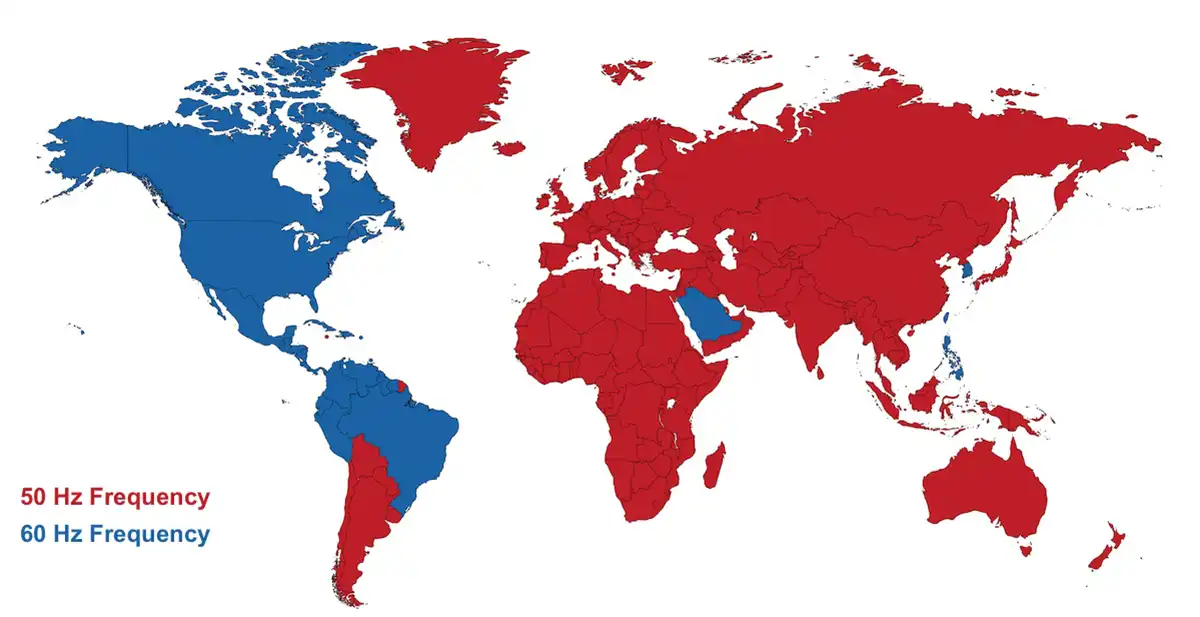The power frequency, typically 50Hz or 60Hz, refers to the number of times alternating current completes a full cycle per second, determining how rapidly the current direction alternates. Globally, two main standards prevail: 50Hz is predominantly used across Europe and Asia, while 60Hz is primarily adopted in North America and parts of Latin America. This frequency selection significantly influences motor performance, grid reliability, and electrical device compatibility. For instance, motors operating at 60Hz run approximately 20% faster than their 50Hz counterparts, whereas 50Hz systems exhibit reduced transmission losses over long distances.
The origin of power frequency and early power systems
In the late 19th century, Thomas Edison’s direct current (DC) system—plagued by high transmission losses and limited voltage scalability—was gradually superseded by the alternating current (AC) system championed by Nikola Tesla and George Westinghouse. AC’s key advantage lay in its ability to be efficiently stepped up via transformers, enabling cost-effective long-distance power transmission. As a result, frequency (Hz), a critical AC parameter, emerged as a focal point in electrical engineering.
Early power systems lacked frequency standardization, with utilities and regions adopting disparate standards—ranging from 16⅔Hz (European railways) and 25Hz (early North American grids) to 40Hz, 60Hz, and even 133Hz (for specialized lighting). These choices often reflected contemporary technical constraints and application-specific demands: low frequencies (e.g., 16⅔Hz or 25Hz) suited early electric motors, while higher frequencies (≥100Hz) minimized incandescent lamp flicker. By the early 20th century, however, grid interconnection and equipment standardization drove consolidation toward 50Hz and 60Hz, which balanced generation efficiency, equipment economics, and transmission performance. This transition not only underscores technological competition but also mirrors the power industry’s shift from fragmented experimentation to global standardization.
50Hz and 60Hz main use areas
The global power system primarily operates on two frequency standards, 50Hz and 60Hz, which emerged as a result of technological evolution and historical contingencies. During the late 19th-century “War of Currents,” where alternating current (AC) triumphed over direct current (DC), these frequencies gained prominence due to their optimal technical and economic trade-offs.
The 60Hz standard, championed by Westinghouse Electric in the United States, was favored for its compatibility with early generator designs and its ability to minimize flickering in incandescent lighting. Meanwhile, the 50Hz standard, promoted by Germany’s AEG, aligned better with the decimal-based metric system. Each frequency offered distinct advantages—60Hz allowed for more compact motor designs, while 50Hz reduced transmission losses over long distances—contributing to grid stability and operational efficiency.

These standards became entrenched through the market expansion and colonial influence of major electrical corporations. The 60Hz system spread across the Americas, western Japan, and South Korea under U.S. technological leadership, whereas 50Hz was adopted across much of Asia, Africa, and Australia through European grid standards. Despite exceptions—such as Japan’s split-frequency system—the persistence of these standards has been reinforced by infrastructure lock-in and technical inertia, solidifying their role as foundational parameters of the global power grid.
| Frequency | Primary Regions | Typical Countries/Regions |
| 50Hz | Europe, Most of Asia, Africa, Australia | Germany, China, India, Russia, France, Australia |
| 60Hz | North America, Parts of Latin America, Western Japan, South Korea | USA, Canada, Mexico, Brazil (partial), Japan (Kansai), South Korea |
Why is there no global standardization for 50Hz and 60Hz, and which frequency is better?
The lack of global standardization in power frequencies—50Hz and 60Hz—stems from divergent technological paths and path dependency established by European and American electrical giants in the late 19th century. The 60Hz system, pioneered by Westinghouse Electric in the U.S., gained dominance in the Americas due to its benefits in equipment miniaturization and industrial efficiency, while Germany’s AEG promoted 50Hz, which became the Eurasian standard owing to its superior long-distance transmission efficiency and compatibility with the metric system.
From a technical standpoint, 60Hz offers advantages in motor speed (20% faster) and compact machinery, making it ideal for precision manufacturing. Conversely, 50Hz excels in long-distance power transmission (reducing losses by 3-5%) and grid stability, better serving heavy industrial demands. Modern studies suggest that both standards represent regionally optimized trade-offs between technical and economic factors. While the renewable energy transition is gradually mitigating frequency differences through flexible transmission technologies, maintaining the current dual-system framework remains more cost-effective than forced unification—a dynamic likely to persist until next-generation power systems fully mature.



